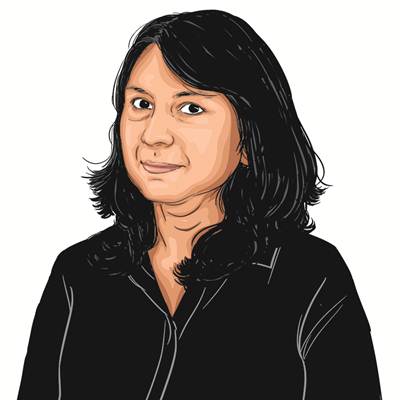Opinion Haryana drama: With change in CM face, BJP’s message is loud and clear — winnability is all that matters
With Khattar out, Dushyant Chautala on the backfoot, the BJP is gambling with Nayab Saini, an OBC face, as CM. Its hope is that a new face can beat anti-incumbency
 In Nayab Saini, the 55-year-old Kurukshetra MP, Haryana gets a Chief Minister from an OBC community. (Express photo by Jasbir Malhi)
In Nayab Saini, the 55-year-old Kurukshetra MP, Haryana gets a Chief Minister from an OBC community. (Express photo by Jasbir Malhi) “Another shrewd democratic experiment.” This is how political observers are likely to describe the swift change of guard in the Haryana CM’s office — from Manohar Lal Khattar to Nayab Saini. Just a day earlier, Prime Minister Narendra Modi had spoken glowingly about the “progressive mindset” of the now former CM, while reminiscing about the good old days when he would ride pillion on Khattar’s motorbike from Rohtak to Gurugram.
The unassuming Khattar was an unexpected choice for Chief Minister. In 2014, the lotus sprang a surprise by winning 47 out of 90 seats in the 2014 Haryana assembly elections, a big leap from two seats in 2009. CM Khattar had just begun to come into his own. He kept a punishing schedule, had all state-related information at his fingertips for anyone who cared to quiz him, and even began to ride his trusty bike for the cameras. Until the very last minute when Khattar proposed Saini’s name, a section in the CMO continued to reassure media persons that he was not going anywhere.
However, the BJP has never shied away from the unpredictable. Cracks in its alliance with Jannayak Janata Party (JJP) had begun to appear last year amid the jousting for the 10 Lok Sabha seats, with Union Home Minister Amit Shah announcing that the BJP would contest all of them. The JJP, led by Dushyant Chautala, former deputy chief minister of Haryana, had also been making similar noises. That it was an alliance of mutual convenience, not shared ideology, wasn’t hidden from anyone. The JJP, born in the run-up to the 2019 assembly polls as a fallout of the vertical split in the Indian National Lok Dal (INLD), found itself playing the role of a kingmaker when it won 10 assembly seats.
 Nayab Singh Saini taking oath as the new Chief Minister of Haryana on Tuesday. (Express photo by Jasbir Malhi)
Nayab Singh Saini taking oath as the new Chief Minister of Haryana on Tuesday. (Express photo by Jasbir Malhi)
In a House where BJP held 40 seats, its arch-rival Congress 31, independents seven, and INLD and Haryana Lokhit Party one each, the JJP’s position was pivotal.
In what wasn’t seen then as a masterstroke, the BJP joined hands with the fledgling JJP, giving its young leader Dushyant, then aged 31, the deputy chief minister’s seat. In one stroke, the party had neutralised the budding opposition. Dushyant, whose voter base is largely rural, stuck to the alliance despite the blowback from the 2020 farm agitation that prompted his uncle Abhay Chautala to resign from the lone INLD seat in the assembly — he won it back in the Ellenabad bypolls in 2021.
Perhaps humbled by its far-from-emphatic win in the 2019 assembly elections, months after sweeping all 10 Lok Sabha seats, the BJP launched one of the most aggressive pushes for direct benefit transfer of various government schemes in the state. In private, Khattar always considered it one of his enduring achievements, besides e-governance, including e-tendering, and MSP for 14 crops.
The current shakeup, weeks before the Lok Sabha polls, appears to be targeted more at the assembly elections slated for October, with a resurgent state Congress. A new CM and cabinet is the easiest way to beat anti-incumbency and shake off all the grievances attached to the old sarkar and a CM who had reigned for nine-and-a-half years. It is also a convenient way to brush off any rancour caused by the wrestlers’ protest in the not-too-distant past or the recent farm agitation in Punjab, and the Haryana government’s muscular response to it.
But the change is not just cosmetic. In Nayab Saini, the 55-year-old Kurukshetra MP, Haryana gets a Chief Minister from an OBC community. Other Backward Classes form over 40 per cent of the state’s population as per the estimates; the Jats comprise only 20-25 per cent. The BJP had kept this mathematics in mind even during the 2014 elections when, in a departure from the past, it installed Khattar, a first-time MLA from Karnal and a Punjabi Khatri, in a state popularly called Jatland with a Jat as its state party chief.
Lately, Congress has also been shining a light on the lack of representation of OBCs, with senior party leader Rahul Gandhi leading the charge. After Congress installed Udai Bhan, a Dalit, as its state party chief in April last year, BJP, too, followed suit with Nayab Saini. Now he has been elevated to the top post.
The great split comes days after Brijendra Singh, the BJP MP from Hisar and a great-grandson of Sir Chhotu Ram, the legendary farmer leader of the state, quit the party to join Congress following differences over JJP. Beset by factionalism, Congress will now have to work harder as the BJP takes advantage of its new look.
But the biggest loser in this exercise is the JJP. The newborn party, which had cast itself as the rightful heir to the INLD, and reaped rich dividends with 10 seats, now finds itself without both power and a constituency. The death of the coalition doesn’t bode well for the INLD as well, once a robust regional party that had ruled Haryana. Ironically, INLD allied with BJP in 1999 only to break it after winning the 2000 assembly polls with 47 seats.
The BJP’s message is loud and clear: Anyone can be a CM, winnability is all that matters.
manraj.grewal@expressindia.com






